Visit Sicily’s Islands
Sicily may be the largest of Italy’s islands but it also has islands of its own. The main island of Sicily can boast approximately 1000 km of coastline but this excludes the archipelagos and islets which sit on two of its three sides. Our range of villas in Sicily provide the perfect base for you to explore these islands, but before you choose the perfect Sicily villa for you, find out more about what these islands have to offer.
Aeolian Islands
The Aeolian Islands archipelago is probably the most famous of Sicily’s islands and is made up of seven separate islands – Vulcano, Stromboli, Salina, Alicudi, Lipari, Panarea and Filicudi – as well as smaller islets – Vulcanello, Basiluzzo, Dattilo, Lisca Nera, Bottaro and Lisca Bianca – and giant boulders. The Aeolian islands are also one of Italy’s UNESCO World Heritage sites.
Vulcano

The Southernmost of the Aeolian Islands, Vulcano, as the name would suggest, is a volcanic island, once believed by the ancient Romans to be the chimney of Vulcan’s workshop (God of Fire). Visitors will always be struck by the sulphuric fumes (similar to rotten eggs) as they arrive. Vulcano is a good starting point for any trip to Sicily’s islands since a hike up its smoking crater – Fossa di Vulcano (Gran Cratere) – will reward you with spectacular views over all the other 6 islands that make up the archipelago. The hiking round trip will take around 3 hours in total and involves a climb of approximately 400 metres. Otherwise, you can also explore the island by bike, quad bike, moped, Mini Moke or by taxi. Or see it from the water by hiring a kayak. Besides hiking to the crater, we also recommend that you bathe in the island’s mud baths and hot springs – the Laghetto di Fanghi – known for their therapeutic properties and marvel at the fumaroles before washing yourself off in the sea.
Vulcanello
Vulcanello sits at the north of Vulcano, connected to the island by a narrow strip of land that is often flooded in bad weather.
Stromboli
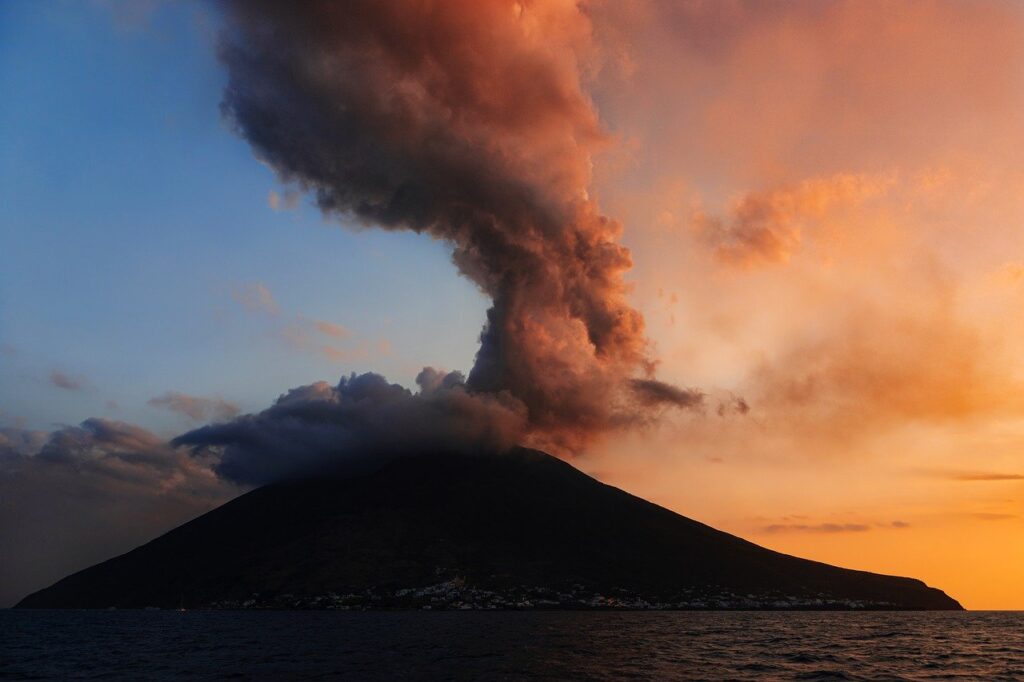
Whilst the last major eruption on Vulcano was back in 1890, Stromboli is one of the most active volcanoes in the world and regularly throws out glowing lava from vents inside its crater earning it the nickname the ‘Lighthouse of the Mediterranean’ since it lights up the sky at night. In fact, during its most active periods, explosions can take place as frequently as every 20 minutes. Visitors can get surprisingly close to these eruptions by standing on the edge of an old crater that sits almost directly above the now active craters. Or alternatively, if you’d rather keep your distance, enjoy the viewpoint which sits above the Sciara del Fuoco, a blackened lava scar that runs down the island’s Northern flank. The hike up will take you about an hour. Whilst this will take you further away from the action, the views from here are still incredible and none more so than after dark, when the fiery emissions are most visible so it’s worth heading there at sunset. Once your stomachs start rumbling as much as the volcano, head down to stop en route at L’Osservatorio, a restaurant where you can continue watching the volcanic spectacle over dinner. Otherwise, visitors should enjoy time in the main village on the island. Or why not enjoy a boat ride around the island to see the Sciara del Fuoco from the sea?
Salina
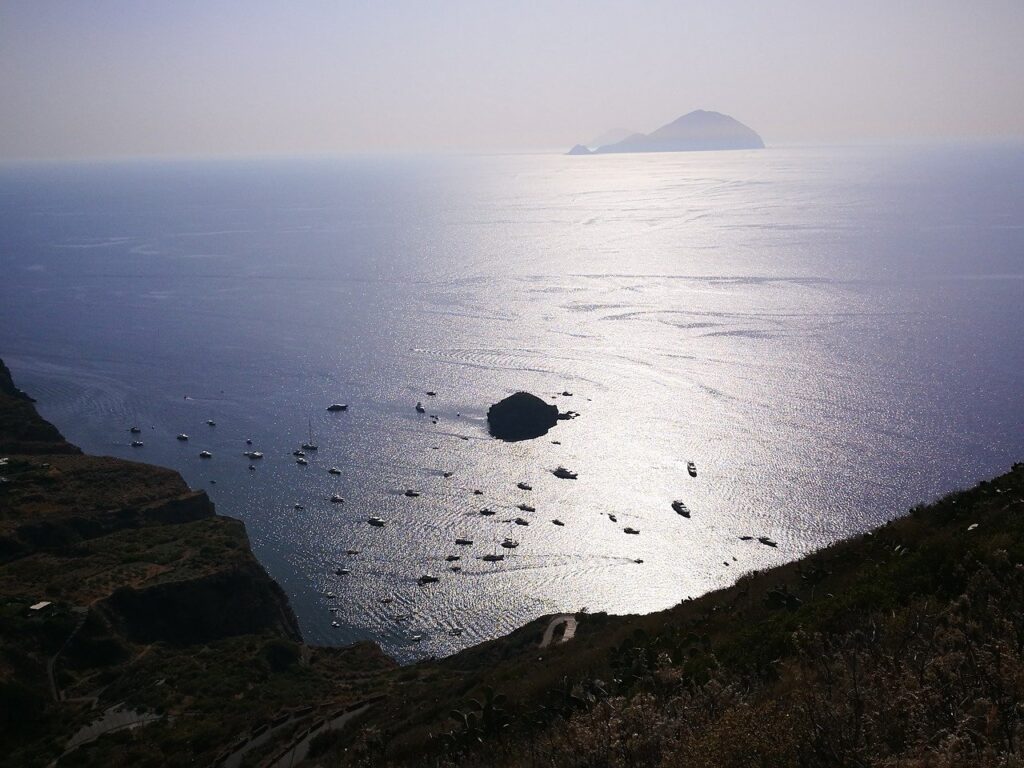
The second largest of the Aeolian islands, the landscape of Salina couldn’t be more different from Stromboli. Instead of volcanic rock, you’ll find green hills covered with vineyards and rural idylls filled with the scent of olive, fig and citrus trees and caper bushes. That’s not to say that the island doesn’t have volcanoes. The green twin peaks actually mark the location of two 13,000 year old extinct volcanoes. Salina has a wonderful charm to it.
Visitors will arrive on the island via one of two ports – Santa Marina Salina or Rinella. Santa Marina Salina is the more important of the two. It’s wonderfully picturesque with a pedestrianised high street which runs at right angles to the waterfront. However, Rinella is just as beautiful and can boast the only sandy beach on the island.
There are a number of other small villages worth visiting on the island, all of which can be accessed using the island’s bus. These include Malfa, a gorgeous rural village characterised by white-washed houses set within gardens and vineyards linked by narrow lanes which would traditionally have been used by mules. It’s tiny but has a lovely little beach and is home to a museum which tells the story of the many islanders who emigrated to Australia and America in search of a better life. Or alternatively, head to Lingua where the salt pans used in Roman times (and which gave the island its name) are still visible. The Museo Civico is here too, home to a number of artefacts and exhibits covering Salina’s fascinating history and industry, including fishing and caper-harvesting. Or explore the picturesque villages of Leni or Pollara, the setting for a number of scenes in the 1994 film, Il Postino. Head down to the shoreline here and spend time sunbathing in front of the cave buildings once used by local fishermen.
Otherwise, enjoy time hiking on the island (there are a number of paths that lead up the tallest of the two peaks) or relaxing on the pebbled beaches and swimming in the sea. And, of course, sample the excellent restaurants on the island too, washing down your food with the sweet Malvasia wine.
Alicudi
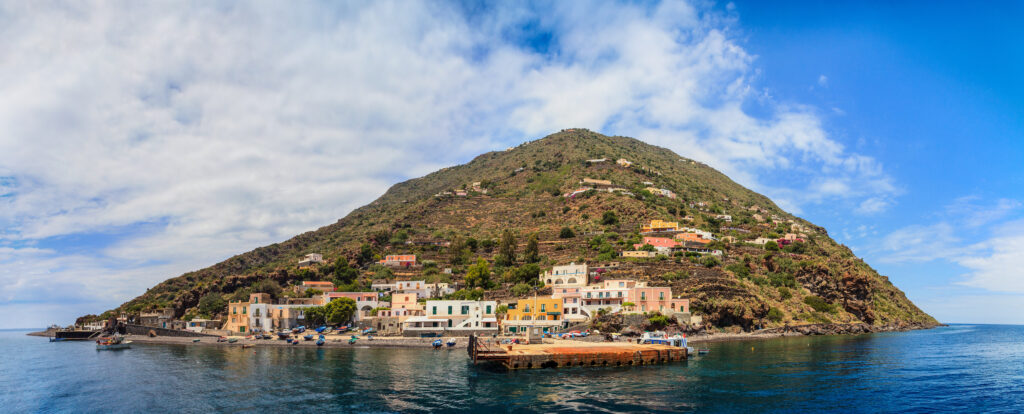
Alicudi has the least number of permanent residents of any of the Aeolian islands and has a rugged charm to it. Visiting Alicudi is in many ways like taking a step back in time – you won’t find many cars here but instead donkeys will take you from place to place. The Western side of the island is pretty inaccessible with any dwellings found on the East. Again, once home to a volcano, vegetation including erica (heather) now covers its slopes and there are numerous paths allowing hikers to explore the island in more detail. The longest path will take you 675 metres above sea level to Alicudi’s summit, Monte Filo dell’Arpa, but will take you several hours.
Find out more about Alicudi courtesy of Jules Brown’s article – Alone on Alicudi.
Lipari
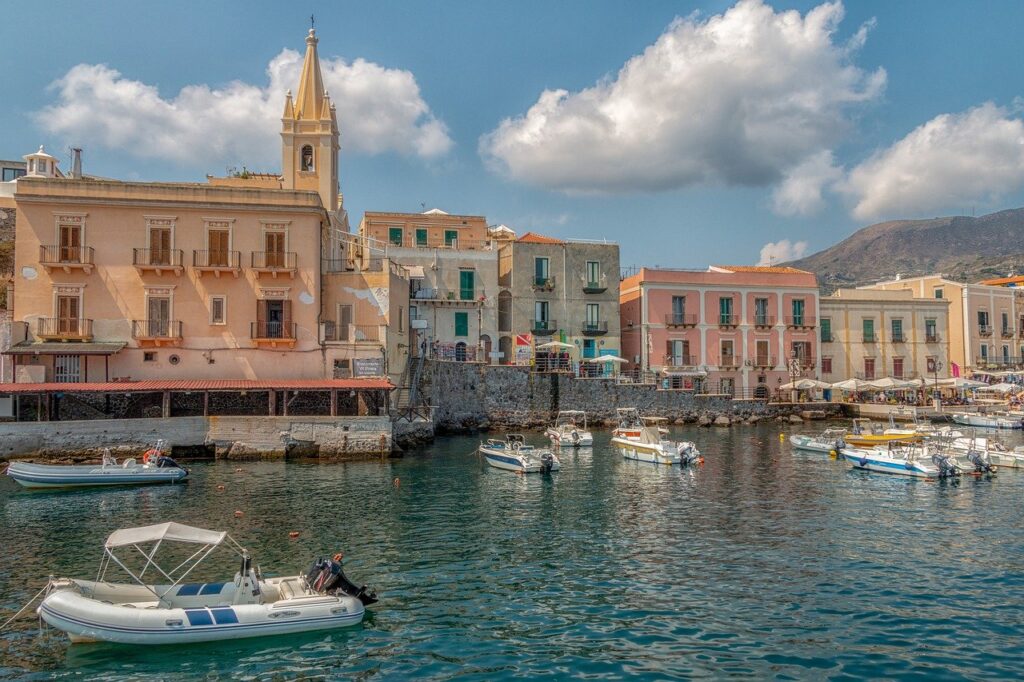
The largest of the Aeolian islands, Lipari is also the most populated and attracts the most holidaymakers. Again, like its neighbours, Lipari does have volcanic origins and its volcano is still considered active but the last eruption was over 1400 years ago. These days, the only signs of the volcanic activity are thermal springs and fumaroles.
The main town on the island is also aptly named Lipari and is lively and bustling with an attractive harbour – Marina Corta – with pastel painted houses along its front, overlooked by a historic 16th century castle. The castle is now home to an excellent museum where visitors can discover much of the Ancient Greek and Roman history of the island and see the collection of amphorae, Greek theatrical masks and other underwater finds such as statuettes commissioned by Sophocles and Euripides that are on display here. (Incidentally, Lipari actually has 2 harbours and if coming by boat you’ll enter the Marina Lunga which is where the hydrofoils and ferries dock).
One of the best ways to explore the rest of the island is by moped or car but if you prefer to use public transport, the towns are connected by a good bus service. Besides Lipari itself, there are also several other towns worth seeing on Lipari. These include Piano Conte which is almost due west from Lipari, Canneto on the Eastern shores, Acquacalda in the North along with Quattropani and Porticello. Alternatively, hike 600 metres above sea level up to the highest peak on the island – Mount Chirica – where you will be rewarded with incredible views of all the other islands on the archipelago
Lipari has been an important port for centuries, and has played a key role in the trade of the island’s main resource – black volcanic obsidian – which is used to make knives and other sharp implements. The island was also the centre of pumice production for centuries. Whilst the mining has now ceased, one of the impacts of this was that fine white pumice dust settled on the sea bed. And it’s for this reason that we highly recommend enjoying a boat tour around Lipari too. Thanks to this layer of fine dust, the waters off Lipari’s Spiaggia Bianca (White Beach) are the clearest and most turquoise we reckon you’ll find in Europe.
Panarea
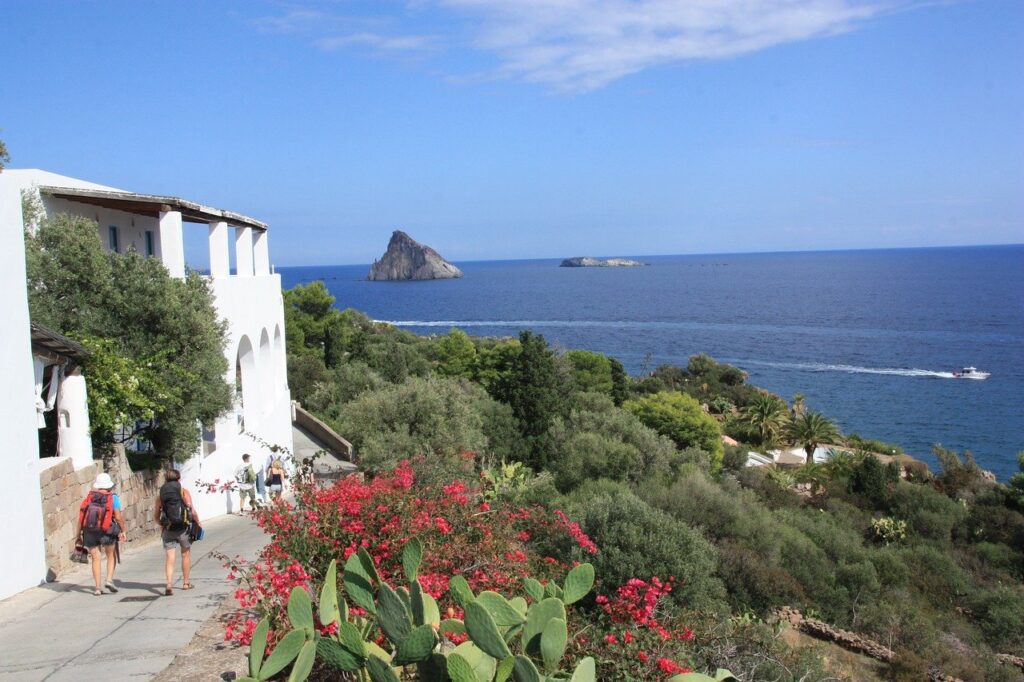
The smallest of the Aeolian islands, Panarea is nothing short of picture-perfect, with white-washed villages covered in brightly coloured bougainvillaea with narrow lanes weaving their way in between. The island attracts a young, chic, upmarket crowd (think of it as Sicily’s answer to Capri) who are also attracted by the lure of the popular open-air night club that draws in the crowds so expect it to be busy from mid July until the end of August. Since there are no cars on the island, transport is charmingly limited to electric bikes and golf carts. And since it isn’t illuminated at night, visitors can enjoy plenty of star-gazing when the sun goes down.
The history of the Aeolian islands stretches back thousands of years and on no island is this more apparent than Panarea, home to the ruins of the Bronze Age settlements of Capo Milazzese. These Bronze Age huts were excavated in the 20th century and sit on headland connected to the island by just a narrow strip of land. It is made up of over twenty dry-stone hut circles. To be honest, apart from this, there isn’t that much to see and do here besides relax, but we do also recommend you take a boat trip out to the coves on the uninhabited south and west shores of the island and explore some of the island’s villages including San Pietro (Panarea’s port), Iditella, Calcara and Drauto. The best beaches on the island are to be found at Cala Junco, a dramatic rocky cove which is one of the island’s main sights, and at Caletta dei Zimmari.
Like the other islands, there is still evidence of Panarea’s volcanic activity to be seen too. Head to the seaside at Calcara and, before you’ll see them, you’ll smell the rotten egg aroma of the fumaroles!
Lisca Bianca
This is an islet that sits off the east coast of Panarea and is only accessible via private boat. It can boast wonderful swimming off a small white sandy beach.
Bottaro
Bottaro is the second smallest of Panarea’s islands and is probably of most interest for what lies beneath its shores, home as it is to the 19th century wreckage of a British ship.
Lisca Nera
This is the smallest of Panarea’s offshore islands, and amounts to not much more than a speck of rock jutting out above sea level.
Filicudi
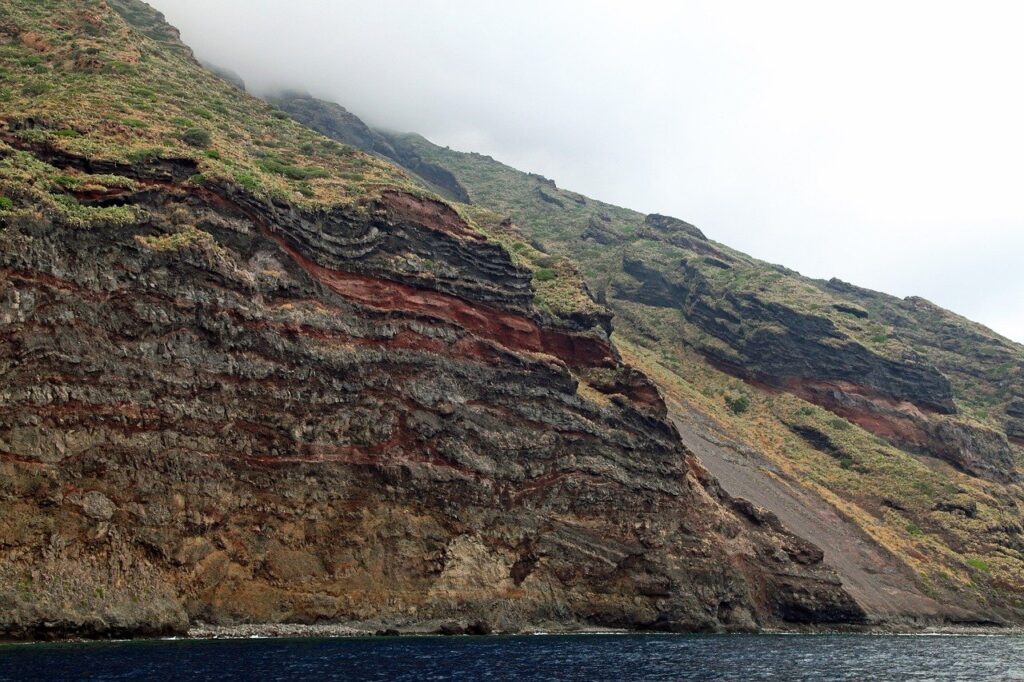
The least developed of the Aeolian islands, and one of the oldest, we think that Filicudi is also one of the prettiest islands in the archipelago. Its rugged coastline, bordered by crystal clear waters and pitted with deep caves and grottoes, is a photographers dream. With only a few villages to boast of – Filicudi Porto, Valdichiesa and Pecorini a Mare – most of the landscape is wild and rural, and it’s known for growing capers and figs. It also has some picturesque beaches including the small beach of Le Punte and Pecorino Mari. Take a boat trip around the island to discover a number of coves only accessible from the sea and to admire the blue waters of the Grotto of Bue Marino or La Canna sea stack.
However, like Panarea, it is also extremely important from an archeological perspective, home to Capo Graziano where visitors will find the remains of around 30 oval Bronze Age huts dating back to around 2000 BC. Incidentally, many of the artefacts discovered here are to be found in the museum in Lipari.
And the walks to be enjoyed here are plentiful. 22 trails will allow you to explore the beauty of the island, taking you to the abandoned village of Zucco Grande and to the 3 peaks – Montegnola, Torrione and the highest of the three, Fossa delle Felci which stands at 773 metres above sea level.
Dattilo
Dattilo is a giant, triangular-shaped, off-shore stack of rocks and part of the Aeolian Islands archipelago.
Basiluzzo
This is a small rocky islet which is now uninhabited, but boasts the ruins of a Roman villa.
Egadi Archipelago
The Egadi Archipelago is made up of three islands – Favignana, Levanzo and Marettimo – along with the islets of Formica and Maraone. The whole area is stunning, and makes up the largest protected marine area in Europe, home to numerous species of fish, sea turtles and even seals. Divers will also find shipwrecks and caves to explore under the water.
Favignana
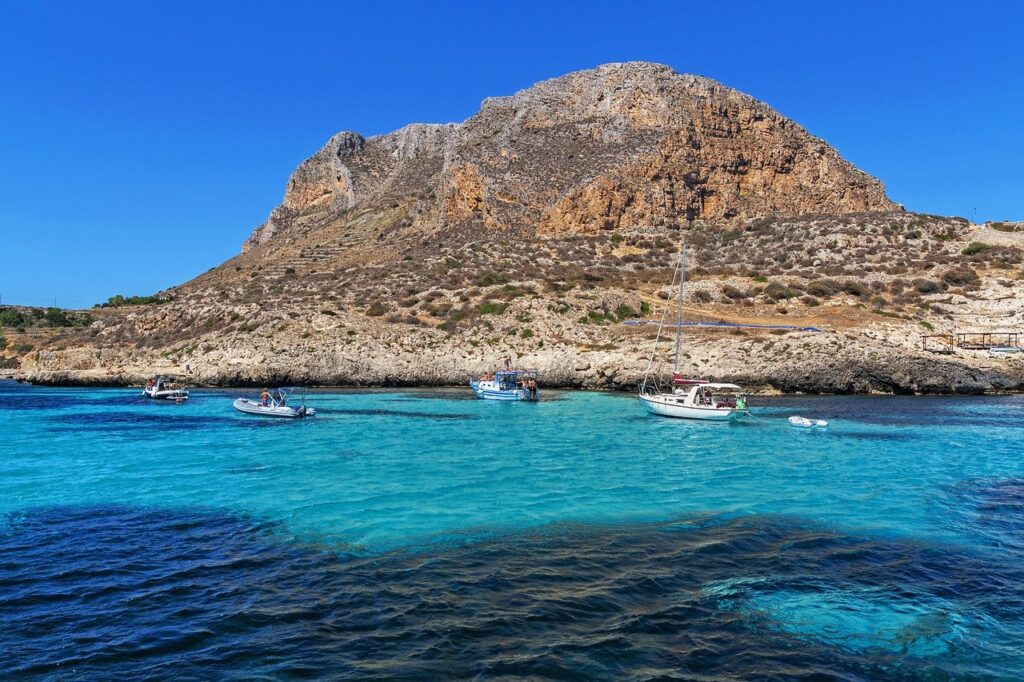
The largest and busiest of the three Egadi islands, the island is sometimes affectionately referred to as ‘La Farfalla’ thanks to its butterfly shape. The island has a long history, certainly dating back to at least Roman times when the Romans dug quarries all over the island to access the tuff stone. The tuff quarries are still visible today. Many are now used for cultivating fruit trees, whilst in others the columns and galleries look almost like the ruins of grand cathedrals and palaces.
More recently, Favignana’s history owes much to Ignazio Florio, one of Italy’s most powerful industrialists who purchased the whole island in 1874 along with the fishing rights that went with it. It’s still possible to see the family’s palazzo in Favignana town, opposite which stood his tonnara and tuna processing plant where Florio invented what was then a ground-breaking idea of preserving tuna in olive oil along with the key-opened tin can. Florio’s empire declined in the early 20th century but the tonnara continued to function until the late 1980s under a series of different owners before being restored in the early 2000s and is now home to a museum dedicated to the history of the tuna fishing industry on the island.
The island’s principal town – Favignana – is absolutely charming and time will be well spent exploring this museum as well as its pedestrianised streets and piazzas. The Fort of Santa Caterina overlooks the town and it’s worth walking up the hill to the fort to enjoy the wonderful views from the summit. Also worth a visit are the churches and the Norman castles of Santa Caterina and San Giacomo.
Otherwise, make time to simply relax in the numerous coves and bays including Cala Rossa, Cala Azzurra and Cala Rotonda along with the Grotta Azzurra, Grotta dei Sospiri and the Grotta degli Innamorati (Lovers Cave), all of which can be visited by boat and which are popular spots for both scuba diving and snorkelling. For those with children, the Lido Burrone may be a safer option as here you’ll find fine white sand and water that only gradually deepen.
Levanzo
As with Favignana, Levanzo has a rich and fascinating history that dates back centuries. In fact, Paleolithic and Neolithic cave paintings can be found on Levanzo at the Grotta del Genovese, depicting scenes from daily life including tuna fishing, dancing and animal husbandry, making it one of the most important and interesting neolithic sites anywhere in the world. Apart from this, there isn’t much to see here apart from the spectacular scenery, home as the island is to just one village – Cala Dogana. Just a short walk from the village though is the small beach at Cala Fredda as well as the beach at Cala Minnola and the most incredibly beautiful Caletta del Faraglione beach, widely considered to be within the top 20 most beautiful beaches in Italy.
And again, this is a wonderful area for divers. Under the sea here, divers can discover the remains of a Roman shipwreck with amphorae and pottery dating back to the 1 BC.
Marettimo
The most remote of the Egadi islands, Marettimo is perfect for walking and hiking enthusiasts. You’ll find dramatic limestone cliffs plummeting down to the turquoise sea below and the most spectacular scenery all around you. There are numerous trails to enjoy but we think that the best views are to be enjoyed at the highest peak on the island – Pizzo Falcone – which sits approximately 500 metres above sea level.
As with the other Egadi islands, Marettimo has had a long and rich history, much of which can still be seen today in the remains of a Roman military outpost that sits above Marettimo town, the Roman settlement remains at the Grotta del Cammello as well as the fortified watchtower on the top of Punta Troia at the northeast of the island. This was built by the Arabs but was subsequently transformed into a castle by the Norman King, Roger II, and then became both a prison and military garrison. Holidaymakers are welcome to visit either by boat or by trekking along the coastal path to reach it.
Otherwise, Marettimo is to be enjoyed just as much off shore as on shore. Its crystal clear waters and numerous caves and grottoes (over 400 in total both above and below water) are a delight for snorkelers and scuba divers alike.
Pelagie Islands
The most southernmost of Italy’s territories, the Pelagie islands are made up of three separate islands: the tiny island of Lampione, Linosa and Lampedusa.
Lampione
Little more than a cliff upon which sits a lighthouse, Lampione is tiny. Geologists actually believe that it was probably part of the main island of Lampedusa but became detached over three million years ago after an earthquake. The island is uninhabited with the exception of some migratory birds and seagulls. But the seas around it are perfect for divers and snorkelers, offering an array of underwater wildlife including coral, lobsters and even a couple of species of sharks.
Linosa
Linosa is a volcanic island characterised by black cliffs and black ground made from lava, covered in green vegetation. Whilst the volcano has been dormant for over 2000 years, its 3 craters – Monte Vulcano (195m), Monte Rosso (186m) and Monte Nero (107m) – are still clearly visible. It’s the perfect place for hikers and keen walkers. Its one and only village – Linosa – is made up of brightly painted houses, creating a unique and charming atmosphere.
It can also boast some beautiful beaches including Cala Pozzolana di Ponente, which as well as attracting holidaymakers, also attracts loggerhead sea turtles who come to lay their eggs. Interestingly, all the turtles born on Linosa are females though, due to the temperature of the sand. If the temperature of the sand in which the eggs are laid sits over 30°C, then all the newborn turtles will be female. Just one degree less than 30°C and male turtles will also appear.
Lampedusa
Lampedusa is the largest of the Pelagie islands and is actually closer to Tunisia (70 miles away) than it is to Sicily (127 miles away). In fact, geographically it is part of the African continent, joined by a shelf under the sea. Lampedusa is, without doubt, most famous for the incredibly blue seas that surround it and its beautiful beaches, including Cala Madonna, Cala Pulcino and the Spiaggia dei Conigli (Rabbit Beach), which many consider to be the most beautiful beach in the Mediterranean and which was voted the world’s best beach by TripAdvisor in 2013. As with Linosa, the beach of Isola dei Conigli (an islet off Lampedusa) is one of the last remaining sites where you will find the loggerhead sea turtles laying thir eggs.
Sicily’s other islands
Sicily is also home to a collection of other islands and islets, details of which are below.
Pallentaria
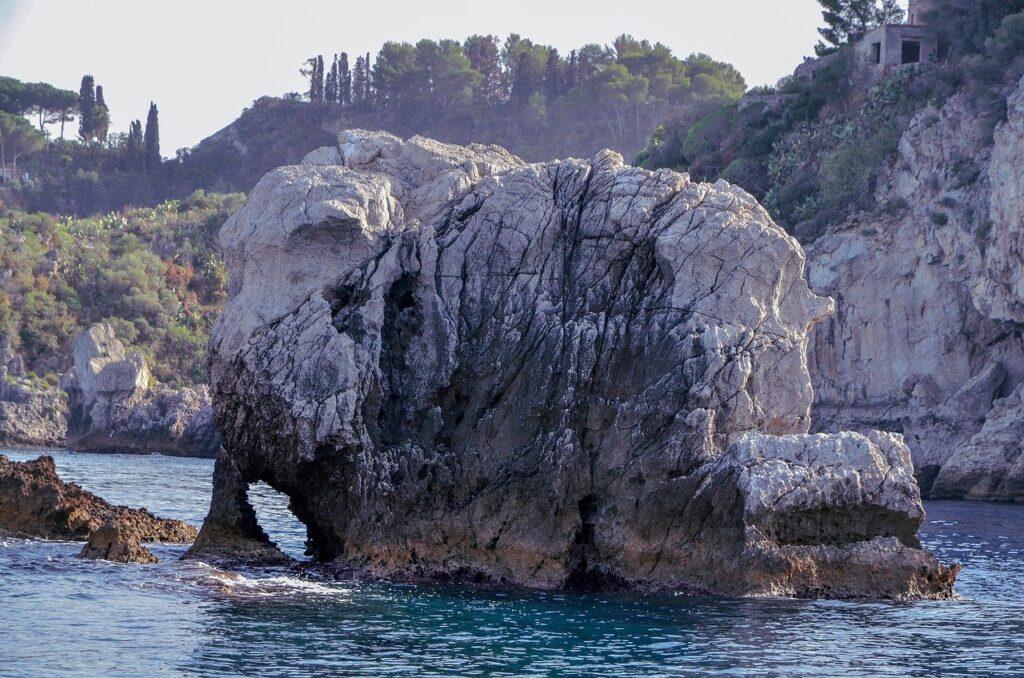
Pallentaria is actually the largest of Sicily’s islands and lies closer to the coast of North Africa than it does to Europe. With just 30 miles of sea between Pantelleria and Tunisia, the Arabic influence on the island is certainly clear to see, not least in the damussi (traditional houses built in lava stone with domed roofs to collect the rainwater) which date back to the 10th century and the names of many of the island villages such as Rekhale, Gadir and Kamma. Even the local wines – Moscato and Passito – are made from Zibibbo grapes imported by the Arabs whilst the traditional dishes such as cubbaita (almond biscuits) and sciakisciuka (a spicy stew) owe their origins to Arabian cuisine.
Hike to the island’s highest peak – La Montagna Grande – around 840 metres above sea level where you can marvel at the incredible views which stretch as far as the coast of North Africa on a cloudless day. And at the bottom of this mountain is the volcanic lake – Lo Specchio di Venere – which legend has it was where Venus stopped to admire herself and compare her beauty to her love rival Psyche.
But again, there is as much enjoyment to be had in the waters off the island than on the island itself. Once again, a series of grottoes and caves make a boat tour around its perimeter extremely interesting. Make sure you take a trip to the ‘Elephant’, a sea stack that, at certain angles, has a rather uncanny resemblance to an elephant’s head and trunk. And watch out for the sheer variety of sea life including monk seals and dolphins that are frequently spotted here.
Ustica
Ustica is a small island just 5 km across but can boast a fascinating history. Its earliest origins can be dated back to the 13th and 14th centuries BC due to the discovery in 1989 of around 300 stone built houses dating from this period. It was subsequently home to the ancient Greeks and Romans and then the Benedictines before passing hands several other times. More recently, until the 1950s, Ustica was used as an island prison and Mussolini banished thousands of political prisoners to the island.
These days, Ustica is absolutely charming and is a popular place for Italians to spend their holidays. It won’t take long to explore but two ways to do so are to take a boat trip around the island and its caves, or to hop on board the island’s little orange bus. A round trip around the island will only take about half an hour but allows you to see Ustica in its entirety. Otherwise, get out on foot to explore Ustica using the main paths and trails. One nice little walk is to head from the main town to Capo Falconiera where you will be able to visit the Bourbon fortress that overlooks the town and enjoy the wonderful views.
As with other Sicilian islands, Ustica is surrounded by shipwrecks and the sea is home to a wealth of marine life so it’s a great area for divers.
Isola Bella
A tiny islet in Taormina, Isola Bella was gifted to Taormina in 1806 by Ferdinand I of Bourbon before being sold to Florence Trevelyan, 80 years later. Since 2011 the site has been transformed into the Museo Naturalistico regionale di Isola Bella, and is open to the public. Find out more in our guide to Taormina.
Ortigia
The historical centre of Syracuse, 3 bridges connect the historical centre (citta vecchia) to the town. Find out more in our guide to 60 things to do in Sicily.
San Pantaleo
The Isola di San Pantaleo is the main island within this archipelago, home to Mozia, an important archeological site discovered by Pip Whitaker. Historic remains include Cappidazzu (where religious sacrifices would once have taken place), defensive walls, a necropolis, the outline of villas, complete with black and white pebbled mosaics. A museum on the island is where you will find many of the artefacts discovered in the excavations including those with both Carthaginian and Greek origins.
Archepelago of the Ciclopi
This is a group of islands that include Lachea Island, Faraglione Grande Faraglione of the Uccelli and Faraglione Piccolo. Once more, they are volcanic in origin and thousands of years ago, are likely to have been part of the Sicilian mainland.
Time to explore Sicily’s islands for yourself? Then check out the Sicily villas available from Bookings For You for your next holiday in Sicily.


